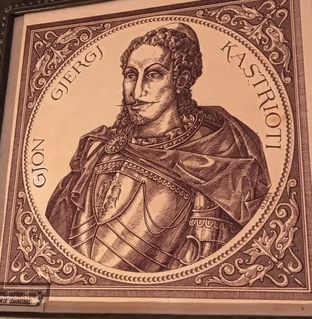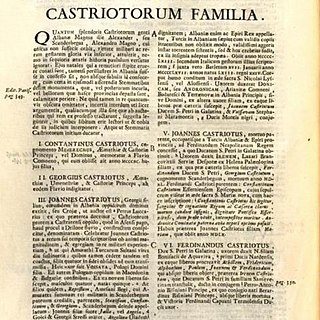
Mat District was one of the 36 districts of Albania, which were dissolved in July 2000 and replaced by 12 newly created counties. It had a population of 61,906 in 2001, and an area of 1,028 km2 (397 sq mi). It was named after the river Mat, which flows through the district. Its capital was the town of Burrel. Its territory is now part of Dibër County: the municipalities of Mat and Klos.

Skadarska Krajina, generally known simply as Krajina is a geographical region in southeastern Montenegro stretching from the southern coast of Lake Skadar to the mountain of Rumija, comprising several villages. It is inhabited almost entirely by Albanians. The area is divided between the municipalities of Bar and Ulcinj.
Gjon Kastrioti was an Albanian feudal lord from the House of Kastrioti and the father of Albanian leader Gjergj Kastrioti. He governed the territory between the Cape of Rodon and Dibër and had at his disposal an army of 2,000 horsemen.

The Kastrioti were an Albanian noble family, active in the 14th and 15th centuries as the rulers of the Principality of Kastrioti. At the beginning of the 15th century, the family controlled a territory in the Mat and Dibra regions. The most notable member was Gjergj Kastrioti, better known as Skanderbeg, regarded today as an Albanian hero for leading the resistance against Mehmed the Conqueror's efforts to expand the Ottoman Empire into Albania. After Skanderbeg's death and the fall of the Principality in 1468, the Kastrioti family gave their allegiance to the Kingdom of Naples and were given control over the Duchy of San Pietro in Galatina and the County of Soleto, now in the Province of Lecce, Italy. Ferrante, son of Gjon Kastrioti II, Duke of Galatina and Count of Soleto, is the direct ancestor of all male members of the Kastrioti family today. Today, the family consists of two Italian branches, one in Lecce and the other in Naples. The descendants of the House of Kastrioti in Italy use the family name "Castriota Scanderbeg".

Martanesh is a geographic and ethnographic region within the Dibër County in eastern Albania. Formerly a commune, at the 2015 local government reform it became a subdivision of the municipality Bulqizë. The population at the 2011 census was 1,836. The settlement holding the status of town is Krastë, which was also the center of the commune. The population is largely Bektashi with a rather small Catholic minority, and the commune contains the Teqe of Martanesh.

Lurë is a former municipality in the Dibër County, northeastern Albania. At the 2015 local government reform it became a subdivision of the municipality Dibër. Its administrator is Leonard Rajta. The population at the 2011 census was 1,096. The region of Lurë is inhabited by the Albanian Lura tribe.
Zall-Reç is a former municipality in the Dibër County, northeastern Albania, made up of seven villages : Kraj-Reç, Zall-Reç, Draj-Reç, Bardhaj-Reç, Hurdhë-Reç, Gjurë-Reç and Ndërshenë. At the 2015 local government reform it became a subdivision of the municipality Dibër. The population at the 2011 census was 681.
Fushë-Çidhën is a village and a former municipality in the Dibër County, northeastern Albania. At the 2015 local government reform it became a subdivision of the municipality Dibër. The population at the 2011 census was 2,909.
Luzni is a former municipality in the Dibër County, northeastern Albania. At the 2015 local government reform it became a subdivision of the municipality Dibër. The population at the 2011 census was 2,433.
Lis is a village and a former municipality in the Dibër County, northern Albania. At the 2015 local government reform it became a subdivision of the municipality Mat. The population at the 2011 census was 3,824.
Derjan is a village and a former municipality in the Dibër County, northern Albania. At the 2015 local government reform it became a subdivision of the municipality Mat. The population at the 2011 census was 1,102. It includes the following settlements: Derjan, Urxallë, Barbullej, Dukagjin, Gjoçaj, Lam i Madh, Zall Gjoçaj.

Trebište, Trebishte, or Trebišta is a village in North Macedonia in Mavrovo and Rostuša Municipality, situated in the Dolna Reka district, on the eastern slopes of Dešat, above the gorge of Radika.

Gjon II Kastrioti, was an Albanian prince and the son of Gjergj Kastrioti Skanderbeg, the Albanian national hero, and of Donika Kastrioti, daughter of the powerful Albanian prince, Gjergj Arianiti. He was for a short time Lord of Kruja after his father's death, then Duke of San Pietro in Galatina (1485), Count of Soleto, Signore of Monte Sant'Angelo and San Giovanni Rotondo. In 1495, Ferdinand I of Naples gave him the title of the Signore of Gagliano del Capo and Oria. While in his teens, he was forced to leave the country after the death of his father in 1468. He is known also for his role in the Albanian Uprisings of 1481, when, after reaching the Albanian coast from Italy, settling in Himara, he led a rebellion against the Ottomans. In June 1481, he supported forces of Ivan Crnojević to successfully recapture Zeta from the Ottomans. He was unable to re-establish the Kastrioti Principality and liberate Albania from the Ottomans, and he retired in Italy after three years of war in 1484.

Kostandin Kastrioti Mazreku was an Albanian regional ruler in parts of the wider Mat and Dibër areas. He is the first Kastrioti to be known by his full name and the progenitor of all members of the family. His son was Pal Kastrioti, grandfather of the Albanian national hero, Skanderbeg.
The Jonima were a noble Albanian family that held a territory around Lezhë, as vassals of Arbanon, Serbia and Ottoman Empire, active in the 13th to 15th centuries. The Jonima, like most Albanian noble families, were part of a fis or clan. It is also said that they had close ties to the Kastrioti family.

Krstoar is a village 4.51 kilometres (2.80 mi) away from Bitola, which is the second-largest city in North Macedonia. It used to be part of the former municipality of Bistrica.
Pal or Gjergj Kastrioti was an Albanian medieval ruler in the latter part of the 14th century in northern Albania. Not much is known about his life. He is mentioned in only two historical sources which describe his rule as extending in a region between Mat and Dibër. His son was Gjon Kastrioti and his grandson Skanderbeg, the Albanian national hero.
Kastriot of Kanina is a figure who is mentioned in 1368 in a letter of Alexander Komnenos Asen, ruler of the Principality of Valona to the Republic of Ragusa in relation to the Ragusan citizenship which Asen had acquired. Kastriot must have been an aristocrat in Kanina and is listed as one of the figures which formed Asen's court. The likeness of his name to that of the Kastrioti family, an Albanian noble family which is first mentioned in archival material a few decades later has been a subject of debate. In contemporary historiography, Kastriot of Kanina is considered unrelated to the Kastrioti family.
Siničane is a village in the municipality of Bogovinje, North Macedonia.
Babje is a village in the Elbasan County, eastern Albania. Following the local government reform of 2015, Babje became a part of the municipality of Librazhd and is under the municipal unit of Qendër Librazhd










